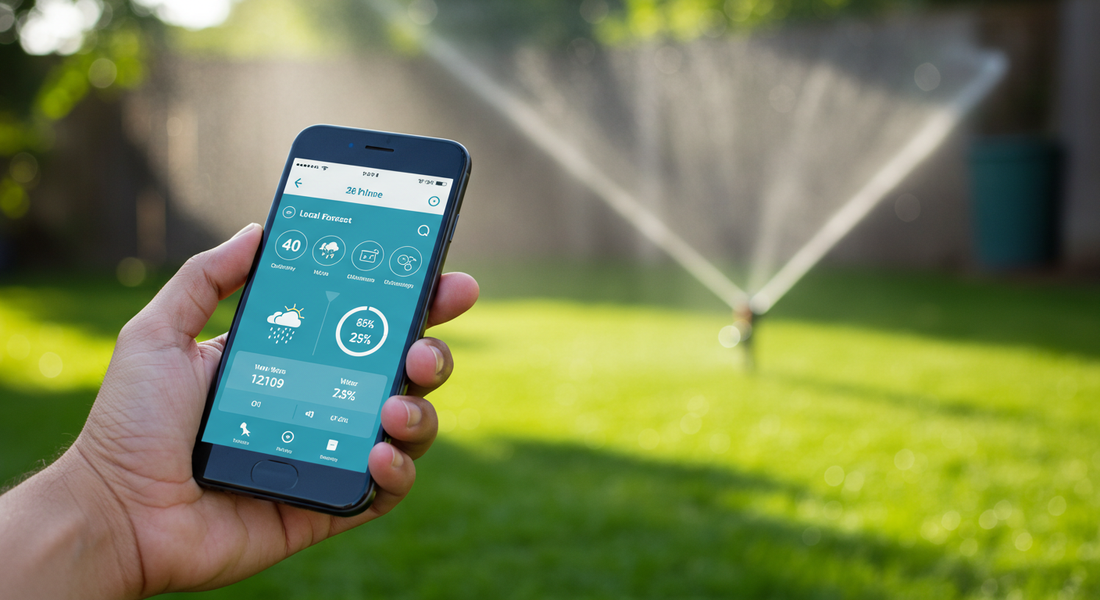
Is a Smart Sprinkler Controller Worth It? A Buyer's Guide
Share
We’ve all seen it: a sprinkler system dutifully watering a lawn in the middle of a torrential downpour. It’s the classic example of an automated system that isn’t very smart.
Traditional sprinkler timers—often called "dumb" timers—run on a fixed schedule, regardless of the weather. They don't know if it rained yesterday, if it's going to rain tomorrow, or if temperatures have dropped below freezing. This leads to wasted water, a higher utility bill, and often a less healthy lawn.
Fortunately, there's a better way. The promise of a modern smart irrigation system is simple: to water your lawn smarter, not harder. By leveraging today's technology, a smart sprinkler controller can automate your irrigation with incredible precision, ensuring your lawn gets exactly the water it needs, right when it needs it. But is it truly worth the upgrade? This guide will break down how they work, what features to look for, and the real benefits for your wallet and your lawn.
How Smart Sprinkler Controllers Work
The magic of a smart sprinkler controller lies in its ability to gather data and make intelligent decisions, moving beyond a simple on/off schedule. There are three core components that make this possible.
1. Connecting to Wi-Fi The first step in its "smart" evolution is connecting to your home's Wi-Fi network. This is the gateway to all its advanced features. Unlike the old timer in your garage that you have to program manually, the best wifi sprinkler controller can be accessed and controlled from anywhere you have an internet connection. This connection allows it to receive data and commands, transforming it from an isolated device into a connected part of your home.
2. Using Weather Data (Weather Intelligence) This is the single biggest advantage over a traditional timer. Instead of a fixed schedule, a smart controller pulls in real-time, hyperlocal weather data from the internet. It uses this "weather intelligence" to automatically adjust your watering schedule. If it rained heavily yesterday, the system will automatically skip the next scheduled run. If rain is in the forecast for tonight, it will delay watering. The most advanced systems can even factor in wind speed (to prevent wasteful evaporation), humidity, and freezing temperatures (to prevent damage to your system). This feature alone is the key to how a smart system can save water lawn.
3. Control via Smartphone App The Wi-Fi connection allows you to manage everything through a dedicated smartphone app. From this app, you can set up initial schedules, manually start or stop a watering cycle, view water usage reports, and customize settings. This means you can adjust your sprinklers from your office, on vacation, or from your couch. The convenience of having total control in the palm of your hand is a significant upgrade in user experience.

Key Features to Compare
Not all smart sprinkler controllers are created equal. As you shop, here are the key features to compare to find the best fit for your home.
-
Number of Zones Supported: A "zone" is a specific area of your yard that is watered by a single control valve. Before you buy, you need to know how many zones your current system has. Most controllers come in 4, 8, and 16-zone models. Simply count the number of zones programmed on your existing timer or look for the valve boxes in your yard to ensure you purchase a model that can support your system.
-
Weather Forecasting and Rain Skip Features: While all smart controllers offer a basic "rain skip," the best models provide more sophisticated weather intelligence. Look for features like "Wind Skip," "Freeze Skip," and "Seasonal Adjust," which automatically alters watering duration based on the time of year. The more data points the controller uses, the more water it can save.
-
Ease of Installation and App Interface: For most homeowners, installing a smart sprinkler controller is a simple DIY project that takes less than 30 minutes. It typically involves removing the old unit, mounting the new one, and connecting the existing zone wires. Look for models with clear instructions and helpful customer support. Equally important is the app's user interface. Is it intuitive and easy to navigate? A well-designed app will make managing your irrigation a breeze, while a clunky one can be a source of constant frustration.
-
EPA WaterSense Certification: Look for the WaterSense label. This is a certification from the U.S. Environmental Protection Agency that verifies the product meets rigorous water conservation and performance criteria. A WaterSense-certified controller is independently verified to be at least 20% more water-efficient than a standard timer. Crucially, many local water utility companies offer substantial rebates—sometimes up to 50% or even 100% of the purchase price—for installing a WaterSense-certified device. Check your local utility’s website before you buy; a rebate could make the decision incredibly easy.
The Real Benefits: Saving Time, Water, and Money
So, what are the tangible results of upgrading to a smart irrigation system?
Case Study: How Much Can You Actually Save? Let’s consider a typical suburban lawn. Over a summer watering season, it might use approximately 60,000 gallons of water. A traditional timer wastes a significant portion of this by watering when it's not needed. According to the EPA, a WaterSense-certified smart sprinkler controller can reduce your outdoor water use by 30% to 50%.
-
Water Savings: 60,000 gallons x 30% = 18,000 gallons saved.
-
Money Savings: The cost of water varies, but at an average rate of $0.004 per gallon, that's a saving of $72 per season. In areas with higher water rates, the savings could easily exceed $150 per year. The controller often pays for itself in just one or two seasons.

The Convenience of Remote Control Beyond the monetary savings is the immense convenience. You can turn on a specific zone for a few minutes to rinse off a patio or let the kids run through the sprinkler, all from your phone. If you're on vacation and a heatwave hits, you can easily adjust the schedule. If you have a landscaper coming, you can pause the system for the day. This level of control removes all the guesswork and hassle from lawn care.
